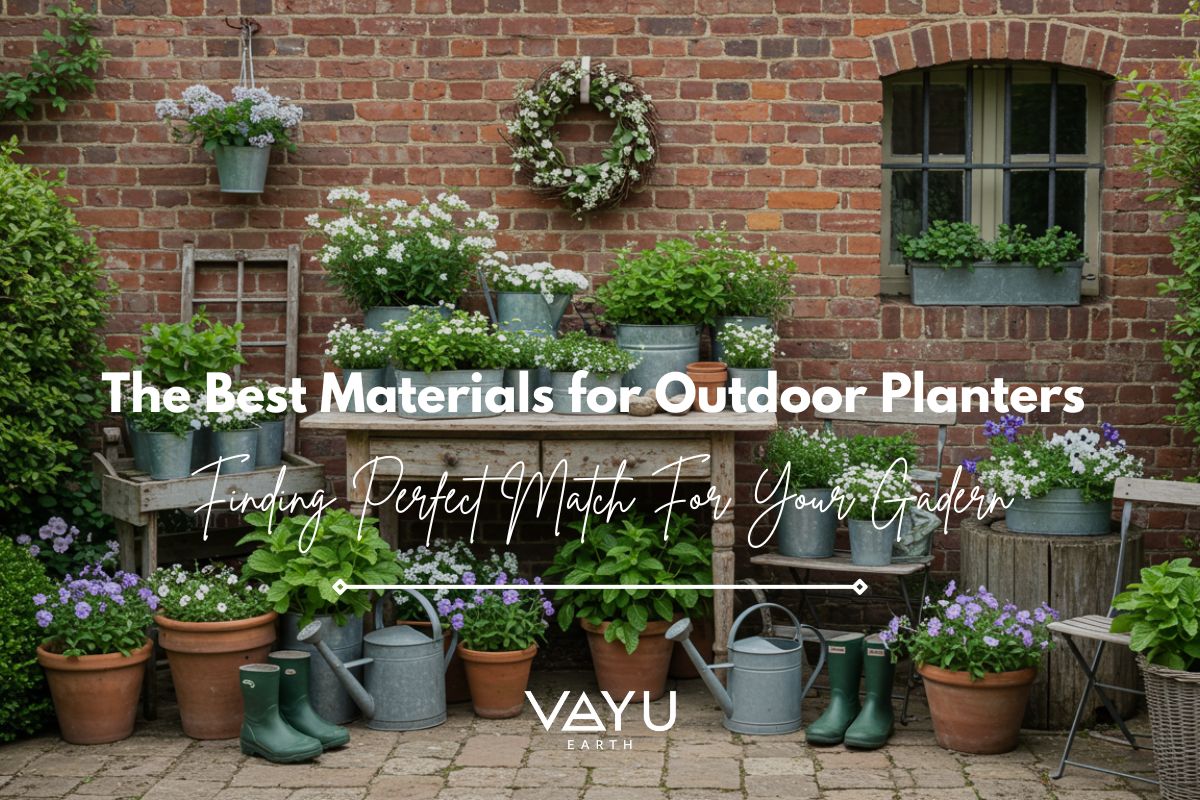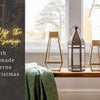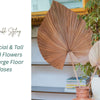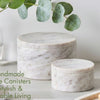The Best Materials for Outdoor Planters: Finding Your Perfect Match

Hello there, fellow garden enthusiasts!
Summer has finally arrived, and with it comes that familiar excitement - longer days, warm breezes, and the perfect opportunity to breathe new life into our gardens. Whether you have a sun-drenched balcony, a cosy patio, or a full garden space, now is the ideal time to plant fresh herbs, vibrant flowers, and lush greenery.
I've been absolutely buzzing to chat with you about something that's been on my mind lately as I've been sprucing up my outdoor space - finding the perfect planters! Is it just me, or does choosing the right containers for your beloved plants feel surprisingly important?
After countless hours spent wandering through garden centres (my happy place!), researching online, and yes, through quite a bit of trial and error in my own garden, I've developed some rather strong opinions about planter materials. I thought I'd share my experiences with you, just as I would if we were having a cuppa and a garden natter over the fence!
Why Material Matters More Than You Might Think
Let me tell you, friends - I learned the hard way that the material of your outdoor planters isn't just about aesthetics. I still remember my disappointment when my gorgeous wooden window boxes rotted through after just two seasons because I hadn't treated them properly. Or that beautiful ceramic pot that cracked during our first winter frost (I may have shed a tear over that one!).

The right material for your planters can:
- Affect how often you need to water your plants
- Determine whether your containers survive the winter
- Impact how heavy and movable your pots are
- Influence the overall look and feel of your garden
- Make a difference to your gardening budget over time
So let's dive into the wonderful world of planter materials, shall we? I'll share what I've learned about each, including my personal favourites and a few tips I've picked up along the way!
Terracotta and Clay: The Timeless Classics
Oh, how I adore the warm, earthy look of terracotta! There's something so wonderfully traditional about these rustic clay pots that instantly gives your garden that coveted cottage feel.
In my experience, terracotta works absolutely brilliantly for Mediterranean herbs like rosemary, thyme, and lavender. Why? Because the porous nature of clay allows excess moisture to evaporate through the sides, preventing that dreaded root rot that so many of us have battled!

However, I must admit that my relationship with terracotta has had its challenges. These pots can be quite thirsty, requiring more frequent watering, especially during our hot summer days. And then there's the winter issue - I've lost count of how many have cracked during frosty spells despite my best efforts to bring them under cover.
My top terracotta tip: Apply a waterproof sealant to the inside of your pots before planting. This little trick has saved many of my favourite pots from deteriorating too quickly while still maintaining that gorgeous aesthetic I love so much!
Natural Fibres: My New Gardening Love
Oh friends, let me tell you about my newest planter obsession - natural fibre planter baskets! Jute, seagrass, and sabai grass planters have absolutely transformed my patio this year, adding wonderful texture and a relaxed, organic feel.

These natural planter baskets bring such warmth to outdoor spaces and work particularly well for indoor-outdoor living areas like my covered patio. I've fallen in love with how they soften the look of more structured gardens and add that perfectly imperfect, lived-in quality.
Most natural fibre planters come with a plastic liner, making them more durable than you might expect. I've been using mine for everything from ferns to trailing ivy, and they make wonderfully characterful herb planters too!

My natural fibre advice: While these generally come with waterproof liners, I still keep mine in areas with at least partial protection from direct rain. I've found they last much longer this way and retain their beautiful natural colour without developing mildew.
Ceramic: Beautiful But Demanding
If you're anything like me, you've probably been tempted by those stunning glazed ceramic planters that come in the most beautiful colours and patterns. They truly can be the statement pieces of your garden or patio!
The glazed finish means these pots don't dry out as quickly as terracotta, which is brilliant for plants that prefer consistent moisture levels. I've found they work wonderfully for my hydrangeas and fuchsias, which throw absolute fits if they dry out too much.
That said, ceramic pots do come with their quirks. They're often quite heavy (my back can attest to this after rearranging my patio last summer!), and they can be on the pricier side. Most crucially, they're not always frost-proof, so do check before purchasing if you plan to leave them outdoors year-round.
My ceramic confession: I've started cheating a bit by placing plastic pots inside my beautiful ceramic planters. This makes them lighter to move around and protects both the plant roots and the ceramic from frost damage. Clever, right?
Wood: Warm and Natural
There's something undeniably charming about wooden planters, isn't there? They blend so beautifully with outdoor settings, weathering gracefully over time to develop that lovely silvery patina.

In my garden, I use wooden planters primarily for larger displays - my raised vegetable beds, for instance, and a lovely deep planter for my collection of mint varieties (keeping mint contained is a lesson I learned the hard way!).
Cedar and oak have proven most durable in my experience, though they do come with a higher price tag. Whatever wood you choose, treating it properly is absolutely essential. I learned this the hard way after my first wooden planters rotted through disappointingly quickly!
I also have a few small wooden planters, which add a lovely rustic charm to my garden with their handcrafted texture.

My wooden planter advice: Line them with plastic (punch drainage holes!) before adding soil, and apply a preservative treatment yearly. This simple maintenance routine has extended the life of my wooden planters tremendously.
Metal: Cottage-y and Durable
I must confess that metal planters weren't originally my cup of tea - they felt a bit too contemporary for my cottage garden aesthetic. However, I've since been converted after finding some gorgeous aged copper and galvanised steel options that add a wonderful textural element to my outdoor space.
Metal planters can last for ages with proper care, and they come in a variety of finishes to suit different styles. I've particularly enjoyed watching my copper planters develop that beautiful verdigris patina over time - nature's own artwork!

One important consideration with metal is temperature fluctuation. These planters can heat up significantly in direct sunlight, potentially cooking your poor plants' roots! I learned this lesson after losing a beautiful heuchera during a particularly scorching week last July.
My metal planter hack: Line metal containers with bubble wrap or hessian before adding soil. This extra layer insulates the roots from temperature extremes and has saved many of my plants from summer heat stress!
Concrete: Solid and Statement-Making But Not Flexible
Concrete planters have become increasingly popular, and I can certainly see why! Their clean lines and substantial presence make them perfect focal points in the garden.
What I appreciate most about my concrete planters is their stability - even the fiercest winds don't topple them (unlike that unfortunate incident with my tall terracotta pots during last autumn's storms!). They're also excellent insulators, keeping soil temperatures more stable than other materials.

The downside, as you might imagine, is their weight. Once filled with soil and plants, my larger concrete planters are essentially permanent features unless I can convince several strong friends to help me move them!
My concrete container tip: Consider positioning these before filling them, and perhaps place them on plant trolleys if you think you might want to move them later. Trust me, your back will thank you!
Plastic: Practical But Not Always Pretty, And Eco-friendly
Now, I know plastic planters might not set your gardening heart aflutter, but bear with me here! Modern plastic pots have come a long way from those flimsy, obviously fake options we used to see.
What I genuinely appreciate about plastic planters is their practicality. They're lightweight, which is an absolute blessing when I'm rearranging my container garden. They retain moisture well, meaning less frequent watering (perfect for when we nip away for a weekend!). And they won't crack in the frost, which is rather marvellous for those of us who lack adequate winter storage space.
I've found that plastic planters work brilliantly for my summer bedding displays. They're affordable enough that I can experiment with different colour schemes each year without breaking the bank.
My plastic planter tip: Look for UV-resistant options that won't fade and become brittle in the sunlight. I've also discovered some fantastic recycled plastic planters that ease my environmental conscience while still being practical—win-win!
Choosing the Right Material for Your Plants and Space
After much experimentation (and yes, some failures!), I've developed a bit of a system for matching plants to planters:
For herbs: Terracotta works brilliantly for Mediterranean herbs that prefer drier conditions. My basil, thyme, and rosemary thrive in these breathable pots.
For flowers that love moisture: Plastic or glazed ceramic helps retain water for thirsty plants like fuchsias, hydrangeas, and impatiens.
For statement plants: Large concrete or substantial wooden planters provide the perfect stage for architectural plants like phormiums or small ornamental trees.
For my patio seating area: Natural fibre baskets create that relaxed, comfortable atmosphere that makes the space feel like an extension of my living room.

Summer Plant Care Tips: Keeping Your Containers Happy
Since we're heading into the warmer months, I thought I'd share a few of my hard-earned summer container gardening tips:
Water deeply rather than frequently. I stick my finger into the soil up to the second knuckle—if it's dry at that depth, it's watering time! This encourages deeper root growth rather than surface roots.
Mulch your containers! A layer of bark chips or pebbles on top of the soil reduces evaporation tremendously. This little trick has saved me so much watering time during hot spells.
Feed regularly. Container plants are entirely dependent on you for nutrients. I use a liquid seaweed feed every two weeks for my flowering plants, and they reward me with the most magnificent blooms!
Consider self-watering systems for holidays. Water-retaining granules mixed into your compost can be absolute lifesavers during hot periods when you're away. I've also invested in a simple irrigation system that's been worth every penny during our summer holidays.

My Favourite Plants for Summer Containers
If you're planning your summer containers now, here are a few combinations that have worked beautifully in my garden:
For sunny spots: Lavender surrounded by trailing lobelia and purple verbena creates the most gorgeous spilling effect. The contrast of the silvery lavender foliage with the vibrant purple flowers is simply stunning!
For herb gardens: Basil, parsley, chives, and thyme in a wooden trough near the kitchen door—practical and pretty! I add nasturtiums for colour, and their peppery flowers are delicious in summer salads.
For shady corners: A mixture of different ferns in natural fibre baskets brings life to those tricky dark spots. Add some variegated ivy trailing over the edges for extra interest.

Final Thoughts: It's All About Balance
After years of container gardening adventures (and misadventures!), I've learned that the perfect outdoor planter collection is all about balance. I mix and match materials, considering both practicality and aesthetics. Some of my plants need the breathability of terracotta, while others thrive in the moisture-retaining properties of plastic or glazed ceramic.
The joy of container gardening lies in its flexibility and the opportunity to experiment. If something doesn't work, you can always try again next season! That's the wonderful thing about gardening—it's a continuous learning journey with new discoveries each year.
What are your favourite planter materials? Have you discovered any brilliant container gardening tricks? I'd absolutely love to hear about your experiences too!
Happy planting, friends! May your containers flourish and your garden bring you as much joy as mine brings me.
Find out more sustainable planters for your garden here!





